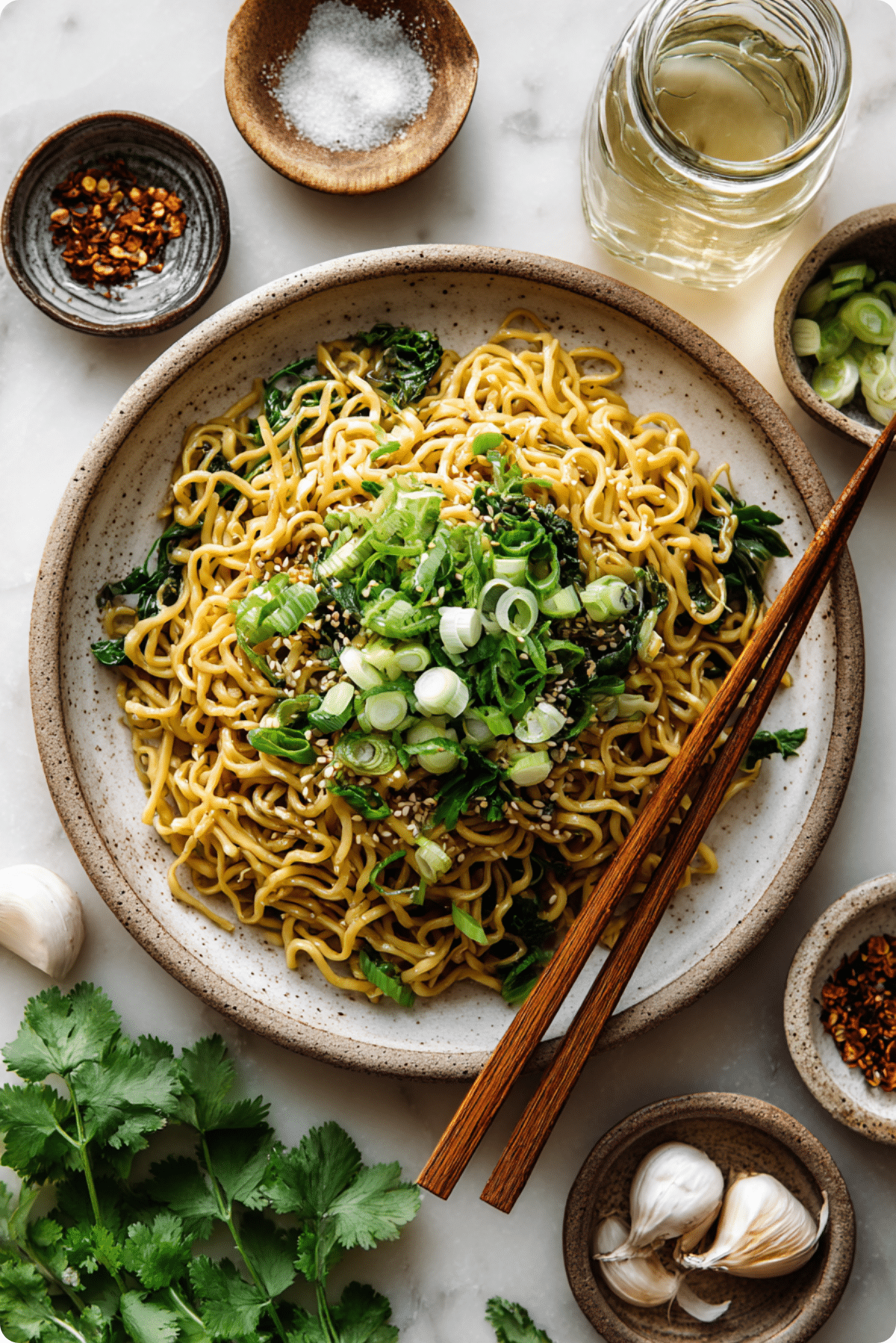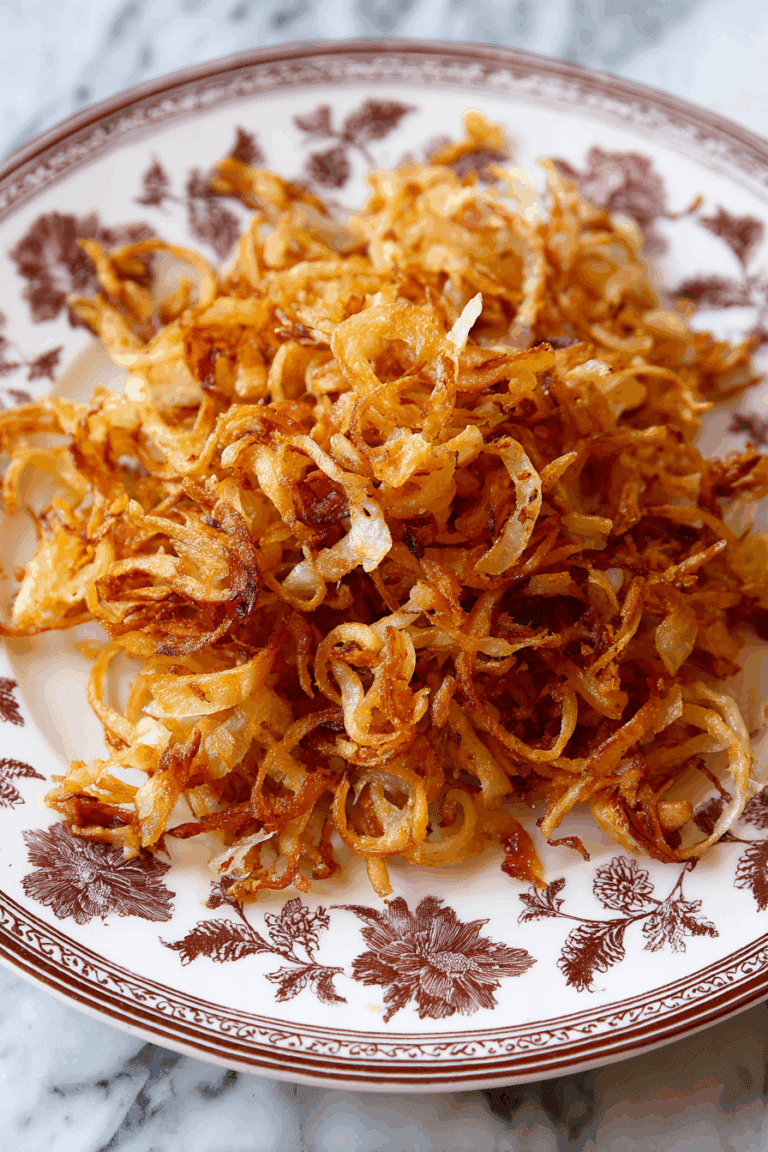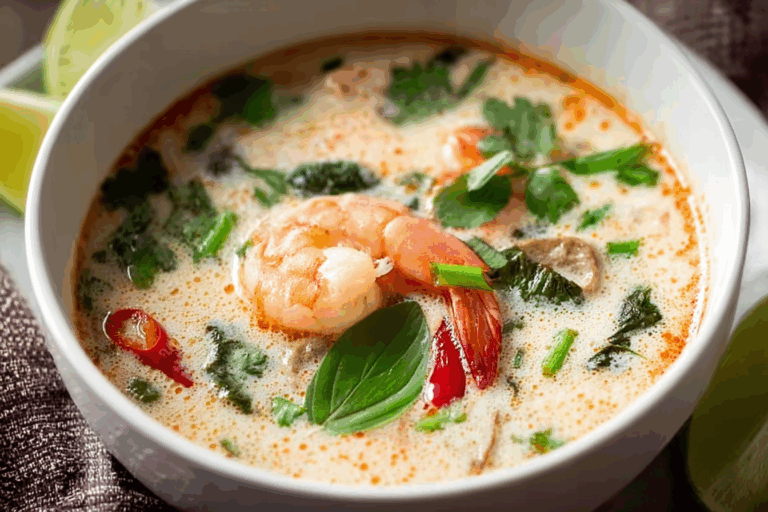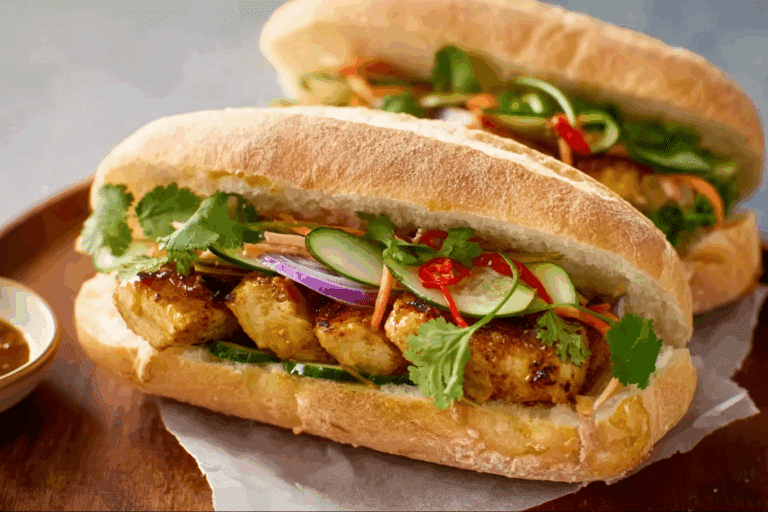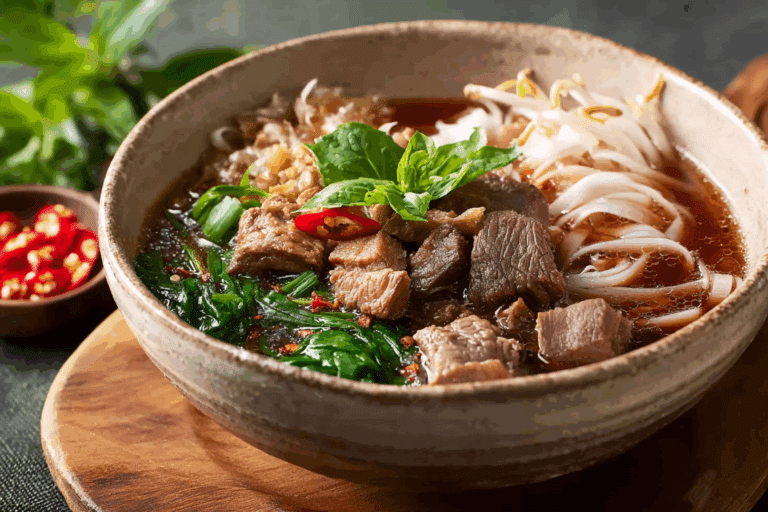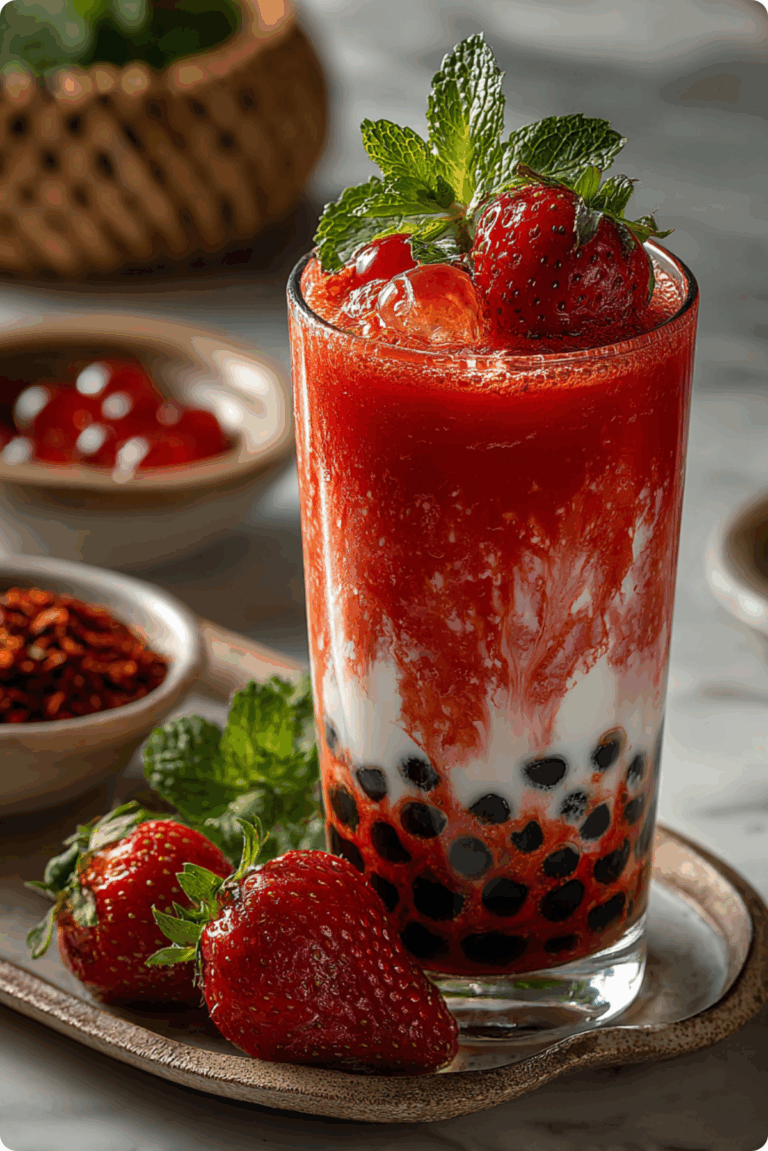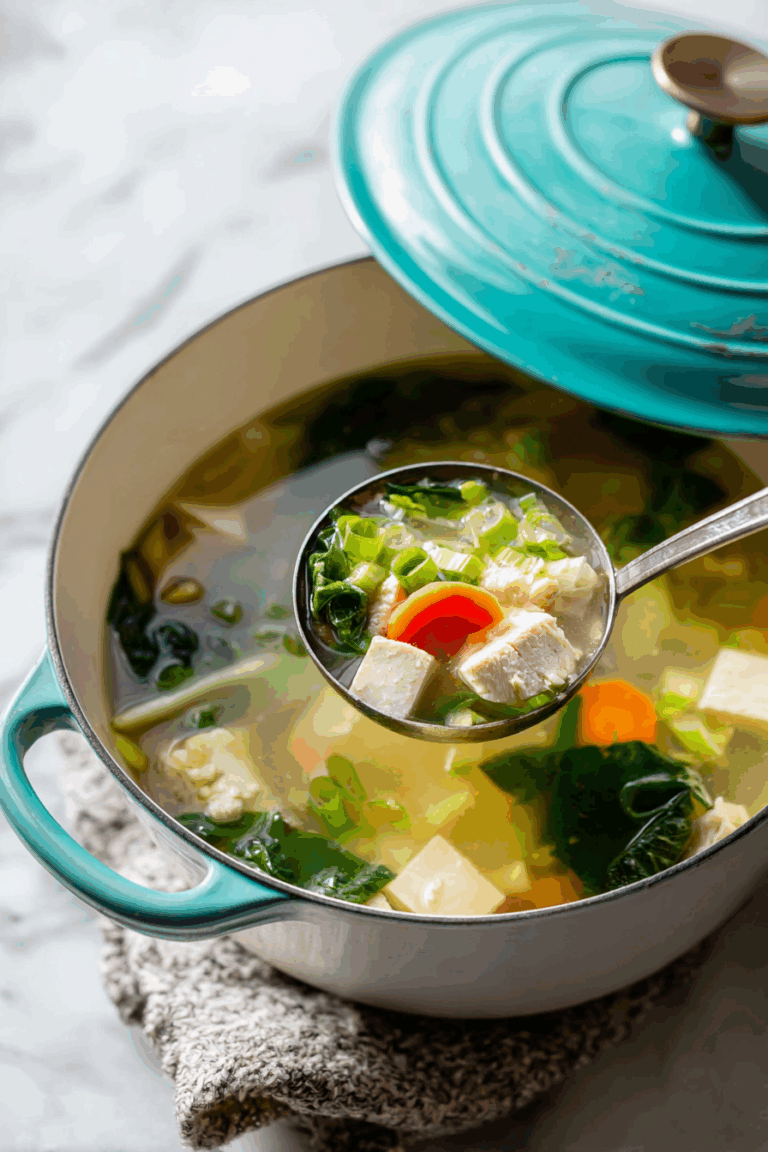The Best Dry Egg Noodles Recipe for Quick Weeknight Meals
Dry Egg Noodles are more than just a simple dish. They are a comforting, flavorful meal that connects families, cultures, and memories. When I first started Just Thai Recipes, my goal was to share the authentic taste of Thai street food with home cooks everywhere. The idea came from watching my grandmother make noodle dishes from scratch in her tiny kitchen. She never followed a recipe, yet every bowl of noodles she made was rich, aromatic, and deeply satisfying. This passion is what inspired the creation of this blog, a place where anyone can learn to make authentic Thai food at home, one plate at a time.
In the heart of Bangkok, Dry Egg Noodles, also known as Bamee Haeng, are one of the most loved dishes sold by street vendors. They are simple yet elegant, made with springy egg noodles tossed in a mixture of garlic oil, fish sauce, sugar, and fried garlic. You can enjoy them plain, crispy wontons, or tender vegetables. The beauty of Dry Egg Noodles lies in their balance of texture and flavor, a delicate harmony between salty, sweet, and aromatic.
In this article, you’ll not only learn how to make authentic Dry Egg Noodles but also discover their cultural background, cooking secrets, and ways to customize them for your own taste. Whether you are new to Thai cooking or already in love with Asian cuisine, this recipe will help you create a dish that feels like home.
Table of Contents
Table of Contents
Ingredients for the Best Dry Egg Noodles
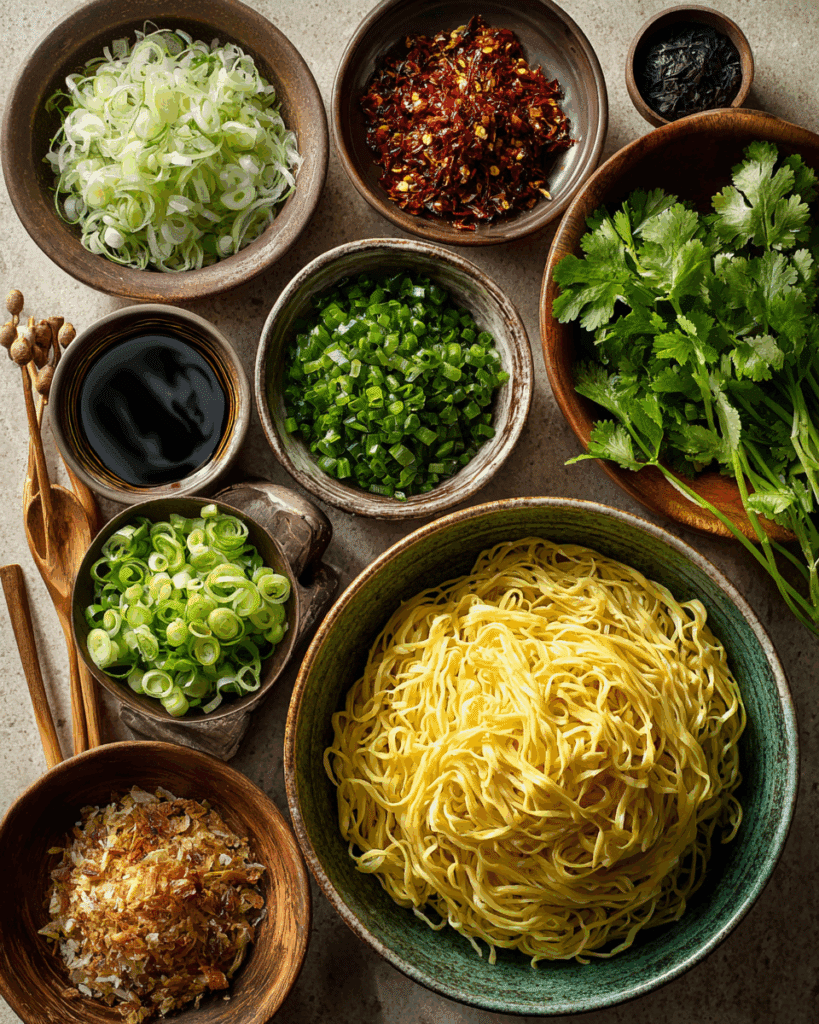
The foundation of delicious Dry Egg Noodles starts with fresh, simple, and high-quality ingredients. Each component contributes to the unique texture and flavor that make this dish unforgettable. Below is everything you need to make one perfect serving.
Ingredients:
- 4 oz egg noodles (1 bun)
- ½ tablespoon fish sauce
- ½ tablespoon sugar
- 1 tablespoon fried garlic
- 1 tablespoon garlic oil
- 1 tablespoon cilantro, chopped
- 1 tablespoon green onions, sliced
- Ground white pepper (optional)
- Dried red chili flakes (optional)
- Toppings of your choice
When choosing egg noodles, try to find the ones that are slightly yellow in color. This comes from real egg yolk and gives the noodles their signature golden hue and soft yet chewy texture. You can find them in most Asian grocery stores, and if you are lucky, at local supermarkets as well.
The fried garlic and garlic oil are the true flavor makers in this dish. They add aroma, depth, and a satisfying crunch. Making them from scratch is easy and worth the effort. To prepare fried garlic, finely chop garlic cloves, fry them in oil until golden, and save both the crispy bits and the oil. This oil becomes the secret that keeps the Dry Egg Noodles from sticking and adds incredible fragrance.
Fish sauce is another essential ingredient, bringing saltiness and umami that balance the sweetness from the sugar. The cilantro and green onions add a burst of freshness that brightens the overall taste. If you enjoy spice, a touch of chili flakes or white pepper will make your bowl come alive with heat.
For toppings, the choice is yours. Many people love adding slices of moo dang, steamed wontons, or blanched Chinese greens like Choy Sum. You can also experiment with grilled chicken, tofu, or shrimp for a twist. This flexibility is one reason Dry Egg Noodles have become a favorite worldwide.
Step-by-Step Instructions to Make Dry Egg Noodles
Cooking Dry Egg Noodles might sound simple, but getting the texture and balance right requires a little attention to detail. The key is to work quickly and keep the noodles from overcooking. Follow these steps carefully to achieve the perfect result every time.
Step 1: Prepare the Ingredients
Start by chopping cilantro and slicing green onions. If you do not already have fried garlic and garlic oil, make them first because they are essential to this dish. Once they are ready, keep them close by, as you’ll use both during the seasoning step.
Step 2: Cook the Noodles
Rinse the egg noodles gently with water to remove any excess flour. Bring a large pot of water to a rolling boil, then add the noodles. Cook them for about 20 to 30 seconds or according to the package instructions. Egg noodles cook much faster than regular pasta, so keep an eye on them. When they are tender but still firm, remove them immediately using a slotted spoon or strainer.
Place the cooked noodles in a bowl and toss them with garlic oil to prevent sticking. This also infuses every strand with that wonderful garlicky aroma.
Step 3: Season the Noodles
Now, add the fish sauce, sugar, and fried garlic directly to the noodles. Sprinkle with white pepper and chili flakes if desired. Use chopsticks or tongs to toss everything together. Make sure every noodle is evenly coated with the seasonings and oil. This is what gives Dry Egg Noodles their rich, layered flavor.
Taste the noodles and adjust the seasoning if needed. Some prefer more sweetness, others more saltiness. There is no single right answer here; it’s all about your personal taste. Finally, sprinkle cilantro and green onions on top for color and freshness.
Step 4: Add Your Favorite Toppings
Dry Egg Noodles can be enjoyed plain, but toppings make them extra special. Try adding slices of roasted pork, crispy wontons, or a spoonful of crushed peanuts. If you’re going for a traditional Thai experience, serve it with a side of broth or a small bowl of soup. This balance between dry noodles and light soup is common in Thai street food stalls.
For more authentic Thai noodle inspiration, check out Rachel Cooks Thai’s Dry Egg Noodles Recipe. It beautifully demonstrates how to create perfect Dry Egg Noodles with a local touch, and you’ll see how Thai vendors layer textures and flavors in every bite.
Cooking is about more than just following a recipe; it’s about feeling the dish come together. The aroma of garlic oil, the sheen of the noodles, and the first bite of that soft yet bouncy texture all remind me of warm evenings in Thailand, where a simple bowl of Dry Egg Noodles could make your day better.
Tips and Tricks for Perfect Dry Egg Noodles
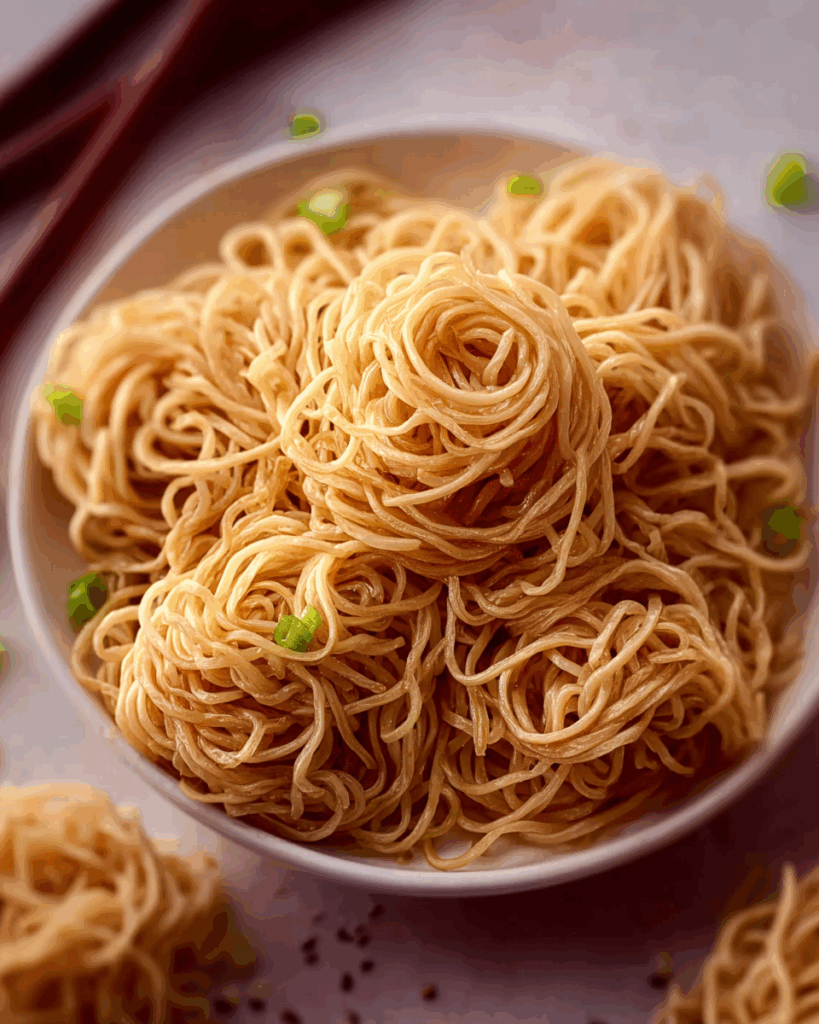
Making Dry Egg Noodles might seem simple at first glance, but the real magic comes from small details that make a big difference. Whether you are new to Thai cooking or someone who already knows your way around Asian ingredients, these tips will help you achieve restaurant-quality results at home. Dry Egg Noodles are all about timing, balance, and aroma, so each of these tricks will bring you closer to that authentic Thai flavor.
1. Use the right noodles and cook them properly.
When preparing Dry Egg Noodles, the choice of noodles matters more than you think. Always go for thin, springy egg noodles made with real eggs, which give them a golden yellow color and a soft bite. Avoid overcooking them, because even a few extra seconds can turn them mushy. Dry Egg Noodles should feel slightly firm when bitten, yet tender enough to absorb the sauce. A quick rinse after boiling helps stop the cooking process and removes any excess starch that can make the noodles sticky.
2. Garlic oil is not optional.
One of the biggest secrets to flavorful Dry Egg Noodles is freshly made garlic oil. It might seem like a small detail, but this oil infuses the noodles with deep, aromatic richness. Simply fry minced garlic in vegetable oil until golden brown, then strain the oil and keep the crispy bits aside. When tossed with Dry Egg Noodles, the oil coats every strand and prevents clumping, while the fried garlic adds crunch and depth.
3. Balance the flavors correctly.
Authentic Dry Egg Noodles are about harmony. You need sweetness, saltiness, and a touch of spice. Fish sauce brings umami and salt, sugar balances it, and chili flakes add just enough heat. Do a taste test after tossing everything together. If the noodles taste too salty, add a small pinch of sugar. If too sweet, balance it with a few more drops of fish sauce. It’s this fine-tuning that separates good Dry Egg Noodles from great ones.
4. Don’t forget the toppings.
Toppings give your Dry Egg Noodles personality. You can add roasted pork, fried wontons, grilled shrimp, or even tofu for a vegetarian twist. Fresh herbs like cilantro and green onions brighten up the bowl. Thai cooks often top Dry Egg Noodles with crispy pork fat or crushed peanuts for extra texture. Mixing different toppings makes each bite interesting and full of flavor.
5. Serve immediately.
Dry Egg Noodles are best eaten as soon as they’re made. The longer they sit, the more likely they are to stick together. If you’re cooking for several people, it’s better to cook and serve one portion at a time rather than in a large batch. The noodles will stay light and bouncy, and the garlic aroma will remain strong.
Following these small but important steps can turn your Dry Egg Noodles from ordinary to unforgettable. Once you master the basics, you’ll realize just how versatile this dish is, and it might even become your go-to comfort meal any day of the week.
Variations of Dry Egg Noodles
One of the most exciting things about Dry Egg Noodles is that they can be made in countless ways. This dish adapts easily to your taste, your mood, or even the ingredients you have at home. The base remains the same, but the toppings and sauces can change to create new flavors every time. Here are a few creative variations that will help you enjoy Dry Egg Noodles in fresh and delicious ways.
1. Dry Egg Noodles with Red Pork (Bamee Moo Dang)
This is the most classic Thai version. Thin slices of roasted red pork are arranged beautifully over a bed of Dry Egg Noodles, often with a few steamed wontons and blanched vegetables on the side. The sweet and savory pork complements the garlicky noodles perfectly. To make it more authentic, serve it with a small bowl of clear broth. This pairing of dry noodles and soup is a beloved Thai tradition.
2. Dry Egg Noodles with Seafood
For seafood lovers, this version is a must-try. Use a mix of shrimp, squid, and fish balls, all lightly boiled and tossed into the noodles. The seafood adds a natural sweetness that pairs well with the fish sauce and garlic. A squeeze of lime at the end gives it a fresh, zesty flavor. You can even top it with a sprinkle of chili flakes for extra heat. These Dry Egg Noodles with seafood are light, satisfying, and full of coastal flavor.
3. Vegetarian Dry Egg Noodles
If you prefer a meat-free option, replace the fish sauce with soy sauce and use fried tofu or mushrooms as toppings. Add more vegetables like bok choy, bean sprouts, or even roasted bell peppers. The garlic oil and fried garlic keep the dish flavorful without any meat. This version of Dry Egg Noodles is nutritious, hearty, and just as satisfying as the traditional one.
4. Vietnamese Dry Egg Noodles
Known locally as Mi Kho, the Vietnamese version of Dry Egg Noodles is slightly different but equally delicious. It often includes char siu pork, shrimp, and sometimes quail eggs. The sauce is slightly sweeter and sometimes includes a touch of oyster sauce. Mixing these elements gives the noodles a distinct regional twist that’s both comforting and bold.
5. Chinese-style Dry Egg Noodles
The Chinese variation focuses more on sesame oil and soy-based seasoning. You’ll find versions that include minced pork or shredded chicken, topped with sesame seeds and chopped scallions. These Dry Egg Noodles have a smooth, glossy texture and a more savory flavor profile, perfect for those who enjoy a rich umami taste.
6. Spicy Thai Dry Egg Noodles
If you love spicy food, this version will be your favorite. Simply add more chili flakes, a spoon of chili oil, or even some crushed Thai bird’s eye chilies. The heat intensifies the garlic and fish sauce, creating a punchy and exciting flavor. Spicy Dry Egg Noodles are popular among Thai street vendors, who often prepare them extra hot for locals who crave that fiery kick.
Every variation has its own charm. The best part is that you can mix and match, finding your favorite balance of texture and flavor. Whether you like them mild, spicy, vegetarian, or with meat, Dry Egg Noodles are endlessly versatile and never boring.
Nutrition and Health Benefits of Dry Egg Noodles
Dry Egg Noodles might taste indulgent, but they also have some surprising nutritional benefits when made with the right ingredients. While they’re not a diet food, they offer a balanced mix of carbohydrates, protein, and healthy fats, especially when paired with vegetables and lean toppings.
A single serving of Dry Egg Noodles typically contains around 350 to 400 calories, depending on toppings and portion size. The noodles themselves provide complex carbohydrates that give you steady energy. Because they are made with real eggs, they also contain a bit of protein and some healthy fats. When you add toppings like grilled pork, tofu, or shrimp, you increase the protein content, making Dry Egg Noodles a well-rounded meal.
The garlic oil used in Dry Egg Noodles offers more than flavor. Garlic is known for its potential health benefits, including helping to reduce cholesterol levels and supporting the immune system. Cilantro and green onions, used as garnishes, provide vitamins A, C, and K, as well as antioxidants that promote healthy skin and digestion.
Fish sauce, although salty, is rich in minerals and adds umami that enhances satisfaction, helping you feel full faster. If you’re concerned about sodium intake, you can replace part of it with light soy sauce or simply reduce the amount used. That way, your Dry Egg Noodles remain flavorful without being too salty.
Adding vegetables such as bok choy, spinach, or bean sprouts not only boosts the fiber content but also introduces more vitamins and minerals. This helps balance out the richness of the noodles and oil. You can even make a healthier version by using less garlic oil and adding leaner toppings like grilled chicken or steamed fish.
Another advantage of Dry Egg Noodles is portion control. Because the dish is so flavorful, even a small serving feels satisfying. You don’t need a huge portion to feel content, which can help with calorie management.
In short, Dry Egg Noodles can fit beautifully into a balanced diet when enjoyed mindfully. They provide comfort, energy, and pleasure all in one bowl. Cooking them at home also lets you control the ingredients and adapt the recipe to your dietary needs, whether that means going low-sodium, adding more vegetables, or using whole-grain noodles. Eating Dry Egg Noodles doesn’t have to feel like a guilty pleasure. When prepared thoughtfully, it can be a nutritious and joyful part of your week.
Make-Ahead, Storage, and Freezing
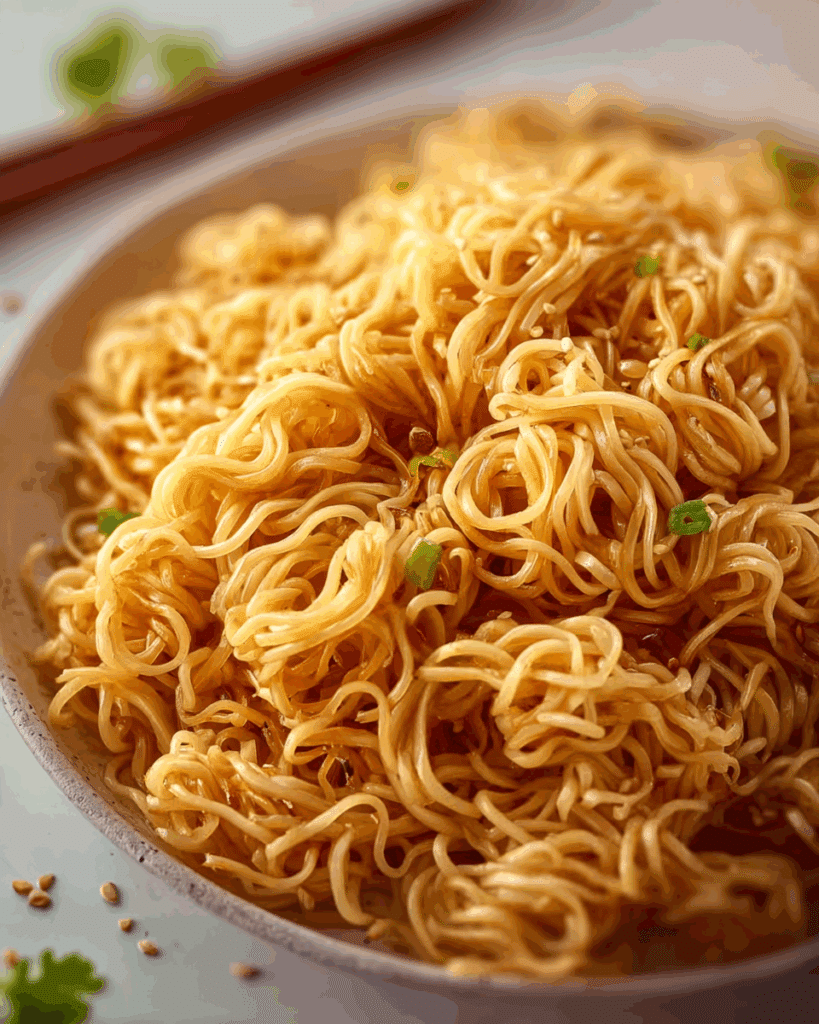
One of the best things about this recipe is how adaptable it is for meal prep. Whether you are cooking for a busy week or just want to have something comforting ready in the fridge, this dish works wonderfully for advance preparation. It is easy to make ahead, store, and reheat without losing its flavor or texture, as long as you follow a few simple steps.
When making this noodle dish ahead of time, start by preparing all the individual components separately. Boil the noodles just until they are slightly firm, then toss them lightly with garlic oil to prevent sticking. Allow them to cool completely before storing. The garlic oil acts as a natural barrier, keeping the noodles soft and bouncy even after refrigeration. You can also prepare the toppings and sauce in advance, storing each in airtight containers.
If you plan to eat within two to three days, keep the noodles in the refrigerator. When you are ready to serve, reheat them quickly in a steamer or microwave with a few drops of water to revive their moisture. Avoid over-microwaving, as it can make the noodles too soft or dry. Toss them again in a bit of fresh garlic oil or sauce to restore the shine and aroma.
For longer storage, freezing is a great option. Place cooled noodles in freezer-safe bags or containers, separating them into single portions. Add a drizzle of garlic oil before sealing to prevent freezer burn. When you want to enjoy them, thaw overnight in the refrigerator and steam or microwave gently. The texture might be slightly softer, but the flavor remains delicious.
If you prefer to freeze the toppings as well, remember that meats like roasted pork or grilled chicken freeze better than vegetables. Fresh herbs and greens are best added right before serving for a burst of color and freshness. You can even freeze the fried garlic and garlic oil in small jars, which saves time for future meals.
Meal prep with this dish also makes weekday lunches easier. Pack cooked noodles in containers, add your toppings separately, and store them in the fridge. In the morning, heat the noodles and mix everything together before eating. The flavor becomes even richer after sitting overnight because the seasonings meld beautifully. For busy families or anyone who loves home-cooked meals with minimal fuss, this recipe truly makes life simpler.
Common Mistakes to Avoid
Even though this recipe is quite forgiving, there are a few common mistakes that can change its flavor or texture. Avoiding these will help you make a bowl that tastes just like it came from a Thai street stall. Cooking this dish is about timing and proportion, so paying attention to details matters.
1. Overcooking the noodles.
The most frequent mistake people make is boiling the noodles too long. Unlike pasta, these noodles cook very quickly, usually within 30 seconds. Leaving them in hot water for even an extra minute can make them soft and gummy. To prevent that, have your colander or strainer ready and remove them as soon as they become tender yet springy.
2. Forgetting to rinse after boiling.
Rinsing helps stop the cooking process and washes away excess starch. Without this step, the noodles might stick together, turning clumpy and heavy. Use cool water for a few seconds, then toss with a bit of garlic oil while still warm. This keeps them separated and glossy.
3. Using too little sauce or seasoning.
This dish depends on the balance between sweet, salty, and aromatic flavors. If you do not add enough seasoning, the noodles can taste bland. Always taste as you go and adjust to your liking. Remember, fish sauce and sugar are the heart of the flavor, and garlic oil ties everything together.
4. Skipping the fresh herbs.
Cilantro and green onions are not just garnish; they are part of the flavor profile. Without them, the dish loses its brightness. Always add them right before serving to maintain their color and fragrance.
5. Reheating incorrectly.
When reheating, never add the sauce too early. Heat the noodles first, then toss them in the sauce afterward. This helps maintain the right texture and prevents sogginess. If you are using a microwave, cover the bowl lightly to trap moisture.
6. Ignoring the balance of toppings.
Too many toppings can overpower the noodles, while too few make the bowl feel plain. Try to find the right balance. A little protein, some herbs, and a touch of crunch go a long way. Keeping variety in texture makes every bite interesting.
Mistakes are a part of learning to cook, but once you understand what to look out for, each attempt becomes easier. The key is to stay patient and trust your senses. Listen for the sound of sizzling garlic, smell the fish sauce blending with sugar, and watch the noodles glisten in oil. That is how you know you are getting it right.
Cultural and Historical Background
Every beloved dish has a story, and this one is no different. Its roots run deep through Asian street food culture, where noodle stalls are an everyday part of life. In Thailand, it is often found on every corner, served from small carts that fill the air with the smell of garlic and sizzling oil. Each vendor has their own version, passed down through generations, which makes it even more special.
The idea of tossing noodles with sauce instead of serving them in broth likely came from Chinese immigrants who brought their culinary traditions to Southeast Asia. Over time, the dish evolved, blending Chinese cooking techniques with Thai seasonings. This cultural exchange created a new kind of noodle experience that became loved across the region. The result was something simple yet deeply flavorful, with a perfect mix of texture, aroma, and balance.
In Thai culture, noodles represent togetherness. Families often share large bowls during meals, and each person customizes their serving with chili flakes, sugar, or vinegar. It is not just about eating but about connecting, laughing, and sharing moments over food. That is why this dish is more than just a meal. It is a symbol of comfort and hospitality.
In Bangkok, many people enjoy it in the morning before work or late at night after a long day. Street vendors set up near busy intersections, and customers gather on small stools, enjoying a hot meal in the open air. The sound of chopsticks tapping against bowls and the smell of fried garlic floating through the air is part of the charm. It is a tradition that continues today, not only in Thailand but also in Thai restaurants around the world.
Its versatility has helped it travel far beyond Asia. In Western kitchens, it has become a favorite for quick weeknight dinners and family gatherings. Home cooks everywhere appreciate how easily it adapts to their taste, whether they prefer a mild, savory, or spicy version. This global love story shows how food can connect cultures through flavor.
The history of this dish tells us something about how traditions evolve. What began as a humble street meal now carries a legacy of shared flavors, adaptation, and comfort. Every bowl made today carries a little piece of that story, reminding us of where it came from and why it continues to bring people together.
Serving Suggestions
Serving a dish like this is about more than just putting food on the table. It is about presentation, balance, and the atmosphere you create around the meal. The way you serve noodles can completely change the dining experience. Whether you’re preparing a cozy family dinner, a small gathering with friends, or a quiet night alone, there are endless ways to serve this recipe that make it feel special.
Start with the bowl. The best serving dishes for this type of noodle are shallow bowls or wide plates, which allow the noodles to spread out rather than pile up. This helps them stay light and prevents clumping. If you have traditional Asian-style bowls, even better, as they keep the heat longer and add a nice touch of authenticity. You can line the bottom with lettuce leaves or a few blanched greens for color and freshness before layering the noodles on top.
Next, think about the toppings and how to arrange them. Instead of mixing everything together immediately, try placing each topping in its own section around the noodles. This not only makes the presentation more appealing but also allows people to mix flavors as they like. For instance, you can arrange slices of roasted pork on one side, steamed wontons on another, and fresh herbs sprinkled right in the center. A small pinch of crushed peanuts or fried garlic on top gives it a final professional look.
The condiments matter too. In Thai restaurants, you will often see a set of four small jars filled with chili flakes, sugar, fish sauce, and vinegar. These are called the “four seasons” of Thai table seasoning. Each person customizes their bowl to their preference, which makes the meal more interactive. Setting out your own mini condiment tray at home makes the experience feel authentic and fun.
If you’re hosting guests, serve the noodles alongside a light soup, like a clear pork broth or a simple vegetable soup. The warm broth balances the dry noodles and adds moisture with every sip. A small dish of pickled vegetables or sliced cucumbers can also help cut through the richness of the garlic oil. For drinks, Thai iced tea, iced coffee, or a refreshing lime soda pair beautifully with this meal.
For a family-style meal, prepare a large platter of noodles with separate bowls of toppings, sauces, and herbs. Everyone can build their own bowl the way they like it. This setup is casual and friendly, perfect for gatherings where food is meant to be shared. It brings a sense of togetherness that mirrors how people in Thailand enjoy their meals on bustling street corners or open-air markets.
Even when eating alone, it is worth taking a few minutes to make your bowl look beautiful. Sprinkle fresh herbs, use a colorful plate, and sit down to enjoy it slowly. Cooking and eating mindfully transforms a simple bowl of noodles into something comforting and meaningful.
Conclusio
Cooking this noodle dish is more than just preparing food; it is about recreating a little piece of cultural warmth in your own kitchen. What makes it truly special is how it combines simplicity and depth. A few basic ingredients, when mixed with care, can turn into a bowl of comfort that feels like home. Every step, from frying the garlic to tossing the noodles in oil, tells a story of tradition and love for good food.
When you make this recipe, you are not just cooking. You are connecting with a culinary heritage that has traveled across countries and generations. It brings people together, whether on busy Thai streets or around your family table. The beauty of this dish lies in its versatility. It can be mild or spicy, meat-based or vegetarian, but it will always carry that signature balance of flavor and texture.
If this is your first time trying it, be patient and enjoy the process. Taste as you go, adjust the seasonings, and make it your own. The more you cook it, the more you will discover little tricks that suit your taste. And soon, you will not even need to follow the recipe, because you’ll understand it by feel, just like the street vendors who have been making it for decades.
FAQ About Dry Egg Noodles
What side dishes go best with this meal?
Light soups, steamed vegetables, or a fresh Thai salad are all great choices. They complement the rich flavor of the noodles and create a well-balanced meal. For something more filling, try pairing it with grilled chicken or pork skewers.
How can I make this dish less oily?
You can reduce the amount of garlic oil by half and add a few spoonfuls of warm broth when tossing the noodles. This keeps them moist and flavorful without being greasy. Another tip is to drain the noodles thoroughly before adding oil.
What can I use instead of fish sauce?
If you prefer a vegetarian option, soy sauce or a mix of soy sauce with a few drops of lime juice works well. It will not taste exactly the same, but it still gives a balanced flavor that fits the dish perfectly.
Can I use other types of noodles for this recipe?
Yes, you can. While egg noodles are the traditional choice, you can use rice noodles or wheat noodles if that’s what you have. Just be mindful of the cooking time, as each type absorbs sauce differently.
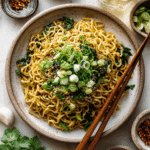
Dry Egg Noodles
- Prep Time: 10 minutes
- Cook Time: 10 minutes
- Total Time: 20 minutes
- Yield: 2 servings 1x
- Category: Main Course
- Method: Boiling and Tossing
- Cuisine: Thai
- Diet: Halal
Description
A flavorful and authentic Thai-style Dry Egg Noodles recipe made with garlic oil, fried garlic, fish sauce, and fresh herbs. This quick and delicious noodle dish delivers the perfect balance of savory, sweet, and aromatic flavors, inspired by Thai street food culture.
Ingredients
- 4 oz egg noodles (1 bun)
- ½ Tablespoon fish sauce
- ½ Tablespoon sugar
- 1 Tablespoon fried garlic
- 1 Tablespoon garlic oil
- 1 Tablespoon cilantro, chopped
- 1 Tablespoon green onions, sliced
- Ground white pepper (optional)
- Dried red chili flakes (optional)
- Toppings of your choice (pork, wontons, vegetables, etc.)
Instructions
- Prepare the ingredients by chopping cilantro and slicing green onions. If you do not have fried garlic and garlic oil ready, make them first by frying minced garlic until golden and saving both the oil and garlic bits.
- Rinse the egg noodles gently in water to remove excess flour. Bring a pot of water to a boil and cook the noodles for 20–30 seconds or according to package instructions. Drain immediately and toss with garlic oil to prevent sticking.
- Add fish sauce, sugar, and fried garlic to the noodles. Sprinkle with white pepper and chili flakes if desired. Toss well to coat evenly and adjust seasoning to your taste.
- Add toppings such as roasted pork, wontons, or vegetables. Arrange them over the noodles and sprinkle with cilantro and green onions. Serve immediately while warm and enjoy.
Notes
- Do not overcook the noodles; they should remain slightly firm for the best texture.
- Use freshly made garlic oil for a rich, aromatic flavor.
- You can substitute soy sauce for fish sauce for a vegetarian version.
- Serve with a side of light broth for an authentic Thai-style meal.
- Best enjoyed immediately after tossing to maintain the ideal texture.
Nutrition
- Serving Size: 1 bowl
- Calories: 380
- Sugar: 3g
- Sodium: 890mg
- Fat: 10g
- Saturated Fat: 1.5g
- Unsaturated Fat: 8g
- Trans Fat: 0g
- Carbohydrates: 60g
- Fiber: 2g
- Protein: 12g
- Cholesterol: 45mg
Keywords: Dry Egg Noodles, Thai Noodles, Garlic Oil Noodles, Thai Street Food, Easy Thai Recipes, Authentic Thai Food

